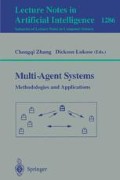Abstract
We present an implementation of an automated reasoning system for multi-agent knowledge and time, which can be used to describe multi-agent environments. Our reasoning procedure is based on a so-called semantic method. That is, suppose that a multi-agent environment is given by a multi-agent knowledge and time modal logic formula set U. To see whether a multi-agent knowledge and time modal logic formula F can be derived from U, all formulas in U and the negation of F are first translated, according to the possible worlds semantics, into a semantically equivalent first-order formula set, from which we then derive a set of first-order clauses. Thus, F logically follows from U iff there is a refutation in the translated clause set. Since we have to use some transitive axioms and deal with inequalities when reasoning about the set of translated first-order clauses, we augment a general purpose first-order theorem proof procedure ME (the Model Elimination) [11] with the capabilities of using transitive axioms and dealing with inequalities. Theory resolution is incorporated into our reasoning procedure for using transitive axioms efficiently. We present our implementation and show some experimental results.
This research is supported in part by the Japanese Ministry of Education and the Artificial Intelligence Research Promotion Foundation.
Preview
Unable to display preview. Download preview PDF.
References
R. Anderson and W.W. Bledsoe, ‘A Linear format for resolution with merging and a new technique for establishing completeness', J. ACM 28, pp 193–214, 1970.
J. Akahani, ‘A Multi-Agent System Simulator Based on Modal Logic', Multi-Agent and Cooperative Computation'91, pp.49–57, Modern Publisher, Japan, 1991.
L. Catach, ‘TABLEAUX: A General Theorem Prover for Modal Logic', Journal of Automated Reasoning 7: pp.489–510, 1991.
C.L. Chang and R.C.T. Lee, 'symbolic Logic and Mechanical Theorem Proving', Academic Press, 1973.
J. Elgot-Drapkin, 'step-Logic and the Three-wise-men Problem', Proceedings of AAAI, pp.412–417, 1991.
P. J. Gmytrsiewicz and E.H. Durfee, ‘Elements of a Utilitarian Theory of Knowledge and Action', Proceedings of IJCAI, pp.396–402, 1993.
G.E. Hughes and M.J. Cresswell, ‘An Introduction to Modal Logic', Methuen, London, 1968.
J.Y. Halpern and M.Y. Vardi, ‘The Complexity of Reasoning About Knowledge and Time: Extended Abstract', Proceedings of the Eighteenth Annual ACM Symposium on Theory of Computing, pp.304–315, 1986.
S. Kraus and J. Wilkenfeld, ‘Negotiations over Time in a Multi Agent Environment: Preliminary Report', pp.56–61, Proceedings of IJCAI, 1993.
R. Manthey and F. Bry, 'sATCHMO: a theorem prover implemented in Prolog', Proceedings of 9th Conference on Automated Deduction, 1988.
D.W. Loveland, ‘Mechanical Theorem Proving by Model Elimination', J. of the ACM 15, pp.236–251, 1968.
F. Lin and Y. Shoham, ‘On the Persistence of Knowledge and Ignorance: A Preliminary report', In the fourth Int. Workshop on Nonmonotonic Reasoning, 1992.
C. Morgan, ‘Methods for Automated Theorem Proving in Nonclassical Logics', IEEE, Transactions on Computers, vol.c-25, No.8, August 1976.
U.W. Schwuttke and A.G. Quan, ‘Enhancing Performance of Cooperating Agents in Real-Time Diagnostic System', Proceedings of IJCAI, pp.332–337, 1993.
M. Stickel, “Automated Deduction by Theory Reasoning', Journal of Automated Reasoning, 1(4):333–356, 1985.
X. Wang and H. Chen, ‘On Assumption Reasoning in Multi-Reasoner System', Proceedings of PRICAI, pp.381–383, 1990.
G. Weiß, ‘Learning to Coordinate Action in Multi-Agent System', Proceedings of IJCAI, pp.311–316, 1993.
Author information
Authors and Affiliations
Editor information
Rights and permissions
Copyright information
© 1997 Springer-Verlag Berlin Heidelberg
About this paper
Cite this paper
He, L., Chaot, Y., Kato, S., Araki, T., Seki, H., Itoh, H. (1997). Implementing an automated reasoning system for multi-agent knowledge and time. In: Zhang, C., Lukose, D. (eds) Multi-Agent Systems Methodologies and Applications. DAI 1996. Lecture Notes in Computer Science, vol 1286. Springer, Berlin, Heidelberg. https://doi.org/10.1007/BFb0030088
Download citation
DOI: https://doi.org/10.1007/BFb0030088
Published:
Publisher Name: Springer, Berlin, Heidelberg
Print ISBN: 978-3-540-63412-6
Online ISBN: 978-3-540-69540-0
eBook Packages: Springer Book Archive

